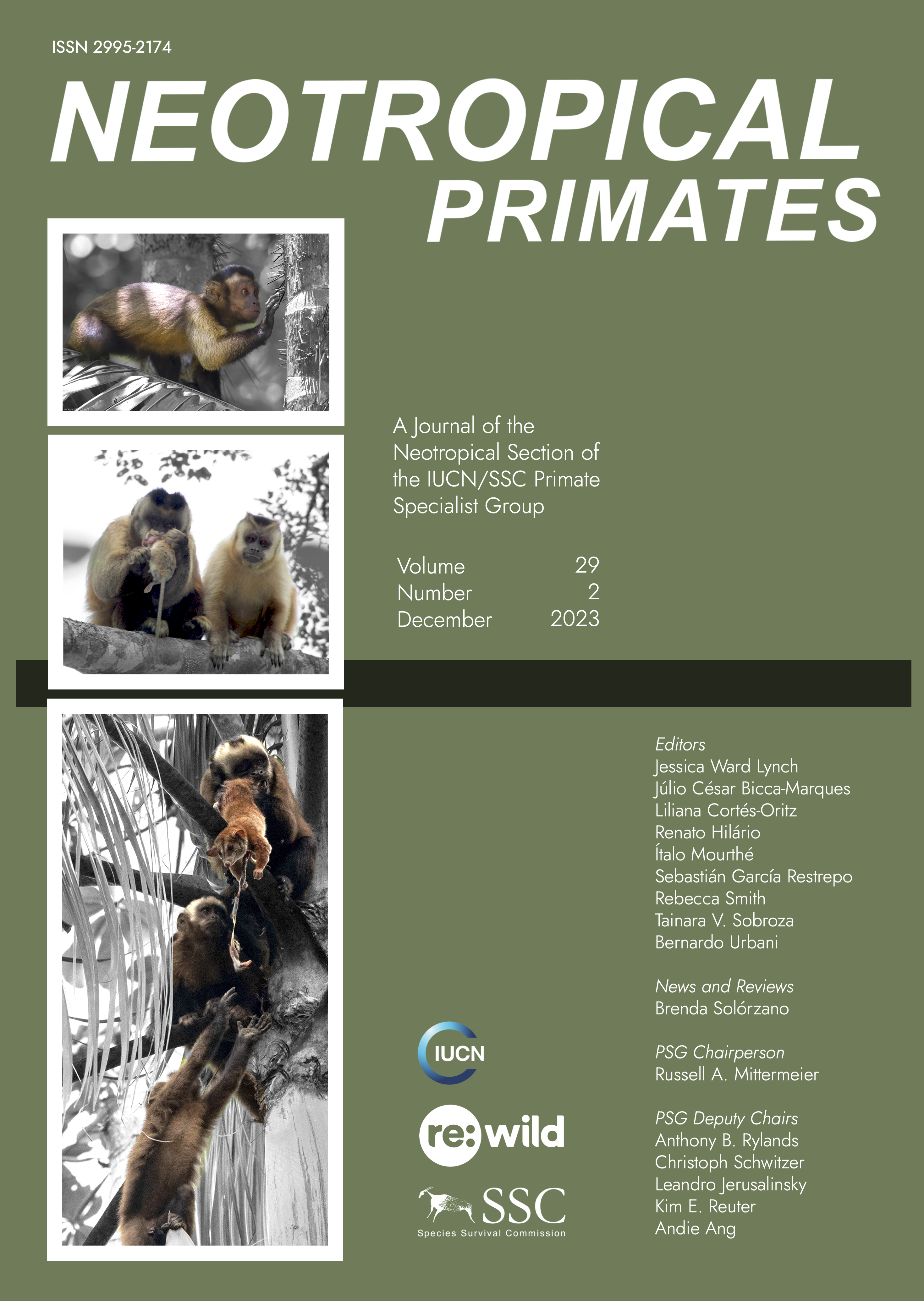Prey transfer through delayed scrounging of a Rhipidomys rodent hunted by an alpha male Sapajus cay
DOI:
https://doi.org/10.62015/np.2023.v29.348Keywords:
Capuchin, group behavior, social hierarchy, interactionAbstract
Cebines’ unique foraging strategies, including opportunistic hunting, allow them to access food sources unavailable to other primates. Although instances of mammal predation have been documented in Sapajus species, reports of spontaneous food sharing and meat interaction remain rare. This study, using ad libitum observations, reports opportunistic hunting and delayed scrounging in a group of Sapajus cay in Mato Grosso do Sul, Brazil. An alpha male was recorded capturing and consuming a rodent (Rhipidomys sp.). While consuming the prey, he dropped scraps that were collected by other group members through delayed scrounging. An estrous female followed the alpha male, exhibiting courtship behaviors but showing no interest in the prey. This event represents a rare observation of vertebrate consumption and passive food transfer in S. cay. These findings highlight the need for further behavioral studies on geographically restricted primate species like S. cay.
References
Agostini, I. and Visalberghi, E. 2005. Social influences on the acquisition of sex-typical foraging patterns by juveniles in a group of wild tufted capuchin monkeys (Cebus nigritus). Am. J. Primatol. 65: 335–351. https://doi.org/10.1002/ajp.20120
Albuquerque, N. M., Silvestre, S. M., Cardoso, T. S., Ruiz-Esparza, J. M., Rocha, P. A., Beltrão-Mendes, R. and Ferrari, S. F. 2014. Capture of a common marmoset (Callithrix jacchus) by a capuchin monkey (Sapajus sp.) in the Ibura National Forest, Sergipe (Brazil). Neotrop. Primates 21: 219–221. https://doi.org/10.1896/044.021.0216
Altmann, J. 1974. Observational Study of Behavior: Sampling Methods. Behaviour 49: 227–266. https://doi.org/10.1163/156853974X00534
Bastos, M., Souto, A., Jones, G., Eason, P., Bione, C., Schiel, N. and Bezerra, B. 2015. Vocal repertoire of wild blonde capuchins (Sapajus flavius) and contextual use of calls. Am. J. Primatol. 77: 605–617. https://doi.org/10.1002/ajp.22384
Carosi, M., Linn, G. S. and Visalberghi, E. 2005. The sexual behavior and breeding system of tufted capuchin monkeys (Cebus apella). Adv. Study Behav. 35: 105–149. https://doi.org/10.1016/S0065-3454(05)35003-0
Christel, M. I. and Fragaszy, D. 2000. Manual function in Cebus apella. Digital mobility, preshaping, and endurance in repetitive grasping. Int. J. Primatol. 21: 697–719. https://doi.org/10.1023/A:1005521522418
Costa, T. M., Silva, D. J., Carniello, M. A., Muniz, C. C., Gusmão, A. C., Silva, O. D., Alves, V. D. S. and Filho, M. D. S. 2020. Predação oportunística de Mico melanurus (Primates, Callitrichidae) por Sapajus cay (Primates, Cebidae) em ecótono entre o Pantanal e a Amazônia. Oecologia Australis 24: 179–184. https://doi.org/10.4257/oeco.2020.2401.15
de Waal, F. B. M., Luttrell, L. M. and Canfield, M. E. 1993. Preliminary data on voluntary food sharing in brown capuchin monkeys. Am. J. Primatol. 29: 73–78. https://doi.org/10.1002/ajp.1350290108
Fedigan, L. M. 1990. Vertebrate predation in Cebus capucinus: meat eating in a Neotropical monkey. Folia Primatol. 54: 196–205. https://doi.org/10.1159/000156444
Ferreira, R., Resende, B. D., Mannu, M., Ottoni, E. B. and Izar, P. 2002. Bird predation and prey-transfer in brown capuchin monkeys (Cebus apella). Neotrop. Primates 10: 84–89. https://doi.org/10.62015/np.2002.v10.510
Filho, R. F., Veiga, S. and Bezerra, B. 2021. Bearded capuchin (Sapajus libidinosus) predation on a rock cavy (Kerodon rupestris) followed by prey sharing. Primates 62: 463–466. https://doi.org/10.1007/s10329-021-00894-x
Genty, E. and Cäsar, C. 2014. Abduction and potential case of predation of an infant howler monkey (Alouatta guariba clamitans) by a tufted capuchin monkey (Sapajus nigritus). Mammalia 78: 401–404. https://doi.org/10.1515/mammalia-2013-0088
Izawa, K. 1980. Social Behavior of the Wild Black-capped Capuchin (Cebus apella). Primates 21: 443–466. https://doi.org/10.1007/BF02373834
Janson, C.H. 1984. Female Choice and Mating System of the Brown Capuchin Monkey Cebus apella (Primates: Cebidae). Z. Tierpsychol. 65: 177–200. https://doi.org/10.1111/j.1439-0310.1984.tb00098.x
Júnior, O. F., Porfirio, G. E. de O., Santos, F. M., Gimenes Nantes, W. A., Oliveira de Assis, W., Braziliano de Andrade, G., Herrera, H. M. and Rímoli, J. 2020. Behavioral activities and diet of Azaras’s capuchin monkey, Sapajus cay (Illiger, 1815), in a forest remnant of the Brazilian Cerrado. Stud. Neotrop. Fauna Environ. 55: 149–154. https://doi.org/10.1080/01650521.2019.1708228
Lee, A. and Huang, M. 2021. Oropendola nest predation and rodent consumption by the black-capped capuchin (Sapajus apella) in the Manu Biosphere Reserve, Peru. Neotrop. Primates 27: 30–32. https://doi.org/10.62015/np.2021.v27.63
Lynch Alfaro, J.W. 2005. Male mating strategies and reproductive constraints in a group of wild tufted capuchin monkeys (Cebus apella nigritus). Am. J. Primatol. 67: 313–328. https://doi.org/10.1002/ajp.20188
Milano, M. Z. and Monteiro-Filho, E. L. A. 2009. Predation on small mammals by capuchin monkeys Cebus cay. Neotrop. Primates 16: 78–80. https://doi.org/10.1896/044.016.0210
Palmeira, F. B. L. and Pianca, C. C. 2012. Predation attempt on a road-killed brown-eared woolly opossum (Caluromys lanatus) by a black-horned capuchin (Sapajus nigritus). Neotrop. Primates 19: 36–38. https://doi.org/10.1896/044.019.0107
Perry, S. 2011. Social traditions and social learning in capuchin monkeys (Cebus). Philos. Trans. R. Soc. Lond. B. Biol. Sci. 366: 988–996. https://doi.org/10.1098/rstb.2010.0317
Perry, S. and Rose, L. 1994. Begging and transfer of coati meat by white-faced capuchin monkeys, Cebus capucinus. Primates 35: 409–415. https://doi.org/10.1007/BF02381950
Perry, S. E., Barrett, B. J. and Godoy, I. 2017. Older, sociable capuchins (Cebus capucinus) invent more social behaviors, but younger monkeys innovate more in other contexts. Proc. Natl. Acad. Sci. 114: 7806–7813. https://doi.org/10.1073/pnas.1620739114
Tiddi, B., Aureli, F., Schino, G. and Voelkl, B. 2011. Social relationships between adult females and the alpha male in wild tufted capuchin monkeys. Am. J. Primatol. 73: 812–820. https://doi.org/10.1002/ajp.20939
Torigoe, T. 1985. Comparison of Object Manipulation Among 74 Species of Non-human Primates. Primates 26: 182–194. https://doi.org/10.1007/BF02382017
Downloads
Published
Issue
Section
License
Copyright (c) 2023 Oscar Fernandes Júnior, Nayara Yoshie Sano, Heitor Miraglia Herrera, Filipe Martins Santos

This work is licensed under a Creative Commons Attribution-NonCommercial-ShareAlike 4.0 International License.



